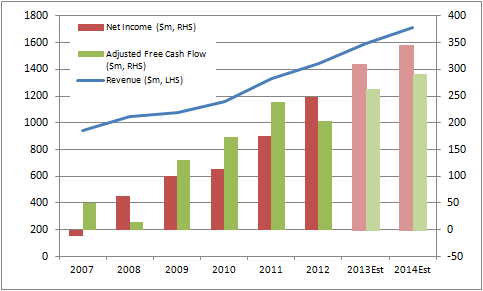When it comes to investing, sometimes it's best to start with the
obvious and look for companies that have the potential to slowly grow.
Contact lens specialist Cooper Companies (NYSE: COO ) is one such stock, and it's definitely worth taking a closer look at it.


Cooper Companies growth prospectsCooper
reports numbers in two separate segments. CooperVision is a soft
contact lens manufacturer generating 80% of revenues. CooperSurgical
generates 20% of revenues, with two-thirds coming from surgical devices,
and one-third from its fast growing fertility treatment products. I'm
going to focus on CooperVision.
Cooper's management is on record as expecting the
soft contact lens market to grow at a 4%-6% clip this year. The bad news
is that, for a second quarter running, the worldwide market only grew
at 4%. This suggests that market demand is not as strong as it could be.
The good news is that CooperVision managed to grow
its sales by 11% over the last 12 months, and there are a number of
reasons why it can continue to grow.
First, its silicone hydrogel lenses (more
comfortable, last longer) revenues now make up 43% of CooperVisions
total. They grew at 22% (constant currency) in the last quarter, and
Cooper can expect to generate more growth in the future from customers
"trading up" to these lenses.
Second, Cooper's management never tires of pointing
out that a customer trading up to its single-use (or one-day) lenses
generates four to six times more revenue and three to five times more
profit. In other words, there is ample room for growth in earnings and
margin growth from expanding one-day sales. For reference, its
single-use sphere revenues only make up 21% of CooperVision revenues
(17% of total company), and they grew at 9% in constant currency in the
last quarter.
Third, Cooper plans to move in on Johnson & Johnson's (NYSE: JNJ ) dominant position in the two-week modality in the U.S. by marketing its own two-week lenses.
Fourth, Cooper has just launched its new branded
one-day silicone hydrogel based lens called MyDay in Europe. According
to the management, MyDay is "not going to be a major influence" next
year because sales are building from a small base. It will take Cooper
time to build up production capacity, but longer-term Cooper should have
good prospects with MyDay.
And finally, Cooper has plans to geographically
expand sales of its leading Biofinity (monthly silicone hydrogel
lenses). Moreover, it can cut costs thanks to not paying royalties,
because sillicone hydrogel patents will expire in the U.S. in 2014 and
globally in 2016.
Threats to growth?While Cooper has been growing, there is no guarantee that it will continue to do so. Indeed, Valeant Pharmaceutical's (NYSE: VRX ) purchase of Bausch & Lomb
suggests that competition will get tougher. For example, Bausch &
Lomb recently launched a one-day lens. Moreover, Valeant has worldwide
plans to generate synergies between its existing dermatology and
eye-care products, and Bausch & Lomb's eye-care solutions. Valeant
will surely invest in trying to expand Bausch & Lomb's international
sales.
Similarly, Johnson & Johnson managed to
accelerate growth in its vision-care segment to 5.4% operationally in
the last quarter, and it cited its one-day lenses as one of "the primary
contributors to operational growth." Cooper is not alone in recognizing
the margin potential of one-day lenses, and Johnson & Johnson has a
formidable distribution network in the kinds of emerging markets that
Cooper wants to expand into.
A look at the numbersCooper has strong prospects, but it also has a strong valuation. Cooper's own EPS guidance has increased throughout the year.

Source: Company presentations.
However, its valuation has more than kept pace, and
it now sits on a forward P/E of over 20 times the mid-point of its
full-year EPS guidance. This looks expensive, but recall that Cooper has
long-term margin expansion opportunities. Furthermore, a better gauge
of its value is to look at its free cash flow potential. I've chosen to
adjusted for the increased capital expenditure program it's undertaking
right now. Cooper is investing in order to develop production capacity
and to accelerate sales of its silicone hydrogel based sales.
In the following table, I have assumed that capital
expenditures equate to depreciation in order to give a better picture
of underlying cash flow generation.

Sources: Company releases, author's estimates for 2013 and 2014.
My underlying free cash-flow estimates of $264
million and $290 million for the next two years indicate that Cooper
continues to generate plenty of cash. However, these figures represent
only around 4% and 4.3% of its current $6.65 billion enterprise value.
Cooper is an attractive company, but its valuation
gives little room for error, and it operates in a very competitive
market against giants like Johnson & Johnson and Novartis (Alcon). It's a great company, but one to keep on your watchlist for now.
No comments:
Post a Comment